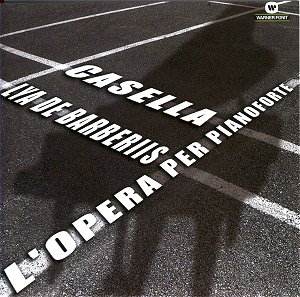Alfredo Casella belongs to the generation (style?)
of Italian composers of mainly non-operatic music that, along with Malipiero,
represents a bridge between the late-romantic inspirations of Respighi
and Martucci, and the modernism/post-modernism of Nono, Berio, Maderna
and Dallapiccola. This three disc set, recorded in 1979, is a superb
testament to his pianistic imagination. It may seem blasé to
equate this music with that of Debussy, Ravel, Stravinsky, Mompou perhaps
(in his more animated moments), but the key words here are neo-classical
and impressionistic, filtered through a very clear compositional process.
The works are presented in chronological order but could have been shuffled
randomly and worked equally well, such is the unity of spirit, character
and utterance of this music.
The first disc starts out with a series of very engaging
pieces, from the earliest years of the 20th century, which
do full justice to their appellations, both in comparison to, say, Ravel,
and even J.S. Bach, if one considers their original provenance. Musical
tributes to (pastiches of?) Wagner, Brahms and Richard Strauss follow,
in addition to the aforementioned French axis, in À la manière
de…
The second disc provides some of the most elusive but
ultimately gratifying music here, with the Sonatina and Nove
Pezzi to the fore. The latter comes across like the creation of
an Italian Bartók, with words like "dirge" and "rustic" prevalent
in the subtitles of a very evocative creation. The salon-like Cocktail's
Dance closes the CD on a lighter note.
The eleven children's pieces (Undici Pezzi…),
which begin disc three, are wonderfully vigorous; again neo-classical
inspirations are not far away but there is also a memorable tunefulness
apparent culminating in a Galop final. Folk/popular influences
inform other tracks on this part of the set and even the wartime late
pieces reveal a joie de vivre not always apparent in music of
this vintage.
Through the efforts of ASV, Naxos and now with Fonit
reissues, a whole generation of "lost" Italian composers is gaining
a wider audience. There is infinitely more to that cultural heritage
than Puccini and Verdi, and the works of composers like Casella and
Malipiero are at last, thankfully, gaining wider recognition. This is
a very desirable set of what ought to be mainstream 20th
century piano repertoire; let's hope that it will be taken up by a vanguard
figure (Hamelin? Hough?). All in all, anyone even slightly enamoured
with piano music would find much here to enrich their quest.
Neil Horner

